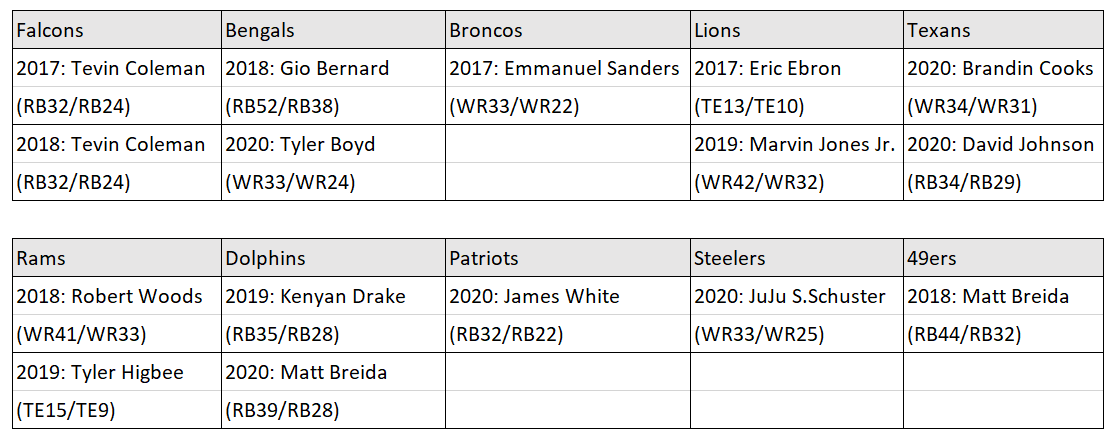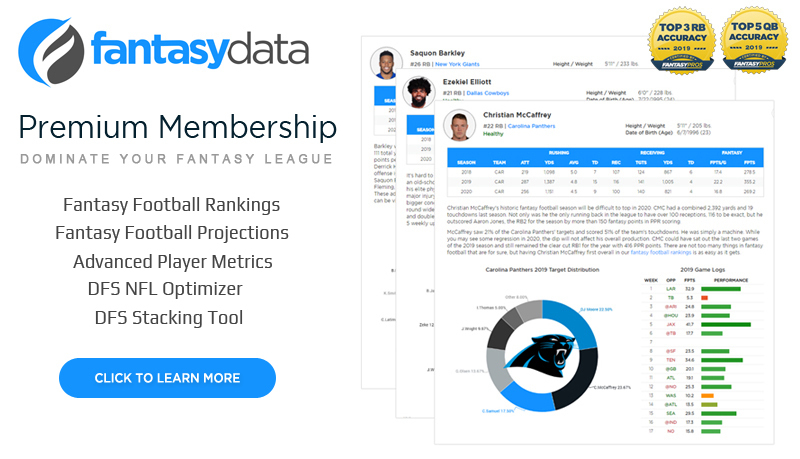Late-Round Sleeper Trend Recognition
Each season in the NFL is vastly different, making it one of the most exciting yet difficult sports to predict. However, there are always a few trends that emerge. Fantasy managers typically draft late-round players from teams who they believe will carve out a role for the player. If a late-round player hits and provides a massive return based on selecting them at a low ADP, it almost always happens to a player that ascends the depth chart to become a featured piece within the offense during training camp or preseason. If it were easy to predict breakout players, then every fantasy manager in every league would be finding late-round value, forcing new strategies to be developed. As it stands, the hit rate for late-round players flourishing into top-24 prospects at their position is low and often a result of injuries, which are impossible to predict.
There are a couple of trends amongst late-round running backs and wide receivers to help identify potential high-volume scenarios. Despite being completely different trends, fantasy managers will benefit from applying this information when drafting late-round running backs, wide receivers, and tight ends. Maximizing the chances of rostering high-value sleeper players to elevate and propel your lineup to a championship should always be the goal in redraft leagues.
Quick Links
Running Backs
The pattern amongst running backs who returned massive value based on their 2020 ADPs can be found by looking at rookie running backs who inherited a backfield. Antonio Gibson (ADP 81.6/RB12), D’Andre Swift (ADP 62.7/RB18), J.K. Dobbins (ADP 69.6/RB21), and Jonathan Taylor (ADP 33.3/RB6) all returned massive value by exceeding their average draft position and solidifying the RB1 role within their respective backfields. Oddly enough, none of these rookie running backs were drafted in the first round, as Clyde Edwards-Helaire was the first running back off the board with the 32nd overall pick in the 2020 NFL Draft. Edwards-Helaire carried a 5.6 ADP premium heading into 2020 fantasy drafts, with Jonathan Taylor coming in nearly 30 spots lower in ADP (33.3) but finishing as the RB6 in half-PPR compared to Edwards-Helaire, who finished as the RB22 after getting his touches reduced following the mid-season signing of Le’Veon Bell.
The 2021 rookie running back class has a few under-the-radar prospects that can be considered late-round sleepers, excluding first-rounders Najee Harris and Travis Etienne, who will both step into massive roles and a guaranteed workload, which is baked into their second and fifth-round ADP. Running backs were taken in the second, third, and fourth rounds of the 2021 NFL Draft including Javonte Williams, Trey Sermon, and Michael Carter. All three of these players are set up to return immense value in lineups based on their current ADPs, which vary from RB3 into RB4 territory. Landing an RB2 in the sixth or eighth round of a fantasy draft is precisely where fantasy managers hope to secure a weekly starter or flex player to return good value on their investment. Building depth is key but ignoring upside, particularly the upside within dual-threat running back prospects who land on bad teams, is a poor decision to make. Williams, Sermon, and Carter are all going to become weekly flex plays by Week 5 at the latest, so make sure to invest during the draft instead of letting them fall to another league manager, even if you already feel satisfied with the running backs you rostered in previous rounds. These early-round rookies were all selected with fairly high draft capital and have minimal competition in their backfields, making them all excellent late-round sleeper picks in upcoming fantasy drafts.
Wide Receivers
Wide receivers who outperformed their ADP in 2020 do not carry the same pattern recognition as rookie running backs. In fact, most of the late-round wide receiver value comes from established prospects who switched teams or younger wideouts who took the next step in their development. Both of these scenarios tend to play out each season, meaning that there are several wide receiving prospects available as late-round sleepers in upcoming 2021 redraft leagues.
An example of a wide receiver who performed better after switching teams was Stefon Diggs, who finished as the WR3 in half-PPR formats in 2020. Diggs was being valued with an ADP of 62.7 following his trade from Minnesota, where he finished as the WR21 in an overall disappointing 2019 campaign. Another wide receiver who dominated with a change of scenery was Deandre Hopkins, who saw his ADP dip to 42.4 before finishing as the WR5 for the Arizona Cardinals during 2020. A couple of established wide receivers who find themselves with a new franchise in 2021 include Julio Jones (ADP 34/WR13) and Kenny Golladay (ADP 48/WR20), who are both big-bodied alpha wideouts capable of delivering massive production in fantasy lineups. While both were in and out of lineups due to injury in 2020, these are two Pro-Bowl receivers who have generated significant production in the past and should get boosted in their new offenses assuming they can stay fully healthy.
Wide receivers available in the same range that Diggs was a year ago include Tyler Lockett (ADP 57.7/WR25), Tee Higgins (ADP 66.3/WR26), and Brandon Aiyuk (ADP 68.6/WR27). Aiyuk and Higgins are a couple of wide receivers that can be described as young and developing, returning to their teams with massive opportunities in their second season. Either of these wideouts could ascend and breakout as bonafide WR1s in 2021.
Tyler Lockett is a different story. He continues to be faded due to the inconsistent involvement he received in 2020 but 2021 promises to be a different story in Seattle, as Pete Carroll hired Shane Waldron from the division rival L.A. Rams to improve their passing attack. Russell Wilson has great chemistry with Lockett but the playcalling often fizzled out due to bad offensive line play and injuries to running back Chris Carson, which allowed defenders to hone in on Wilson and eliminate Lockett. He is currently being drafted at his floor as the WR25, while D.K. Metcalf is being drafted at his ceiling as the WR6 in half-PPR formats. Take advantage of the industry fade on Lockett, as his targets and involvement in the offense will become more consistent, despite finishing 2020 as the WR9 and surprisingly commanding a higher target share than Metcalf.
Best Teams To Historically Target Late-Round Sleepers
Focusing on running backs, wide receivers, and tight ends since 2017, a few teams have shown a tendency to produce at least one late-round sleeper prospect, which I’m defining as the seventh round or later. It’s likely that at least one of the following teams will yield a valuable RB3/WR3/Flex player to help provide an edge towards winning leagues in 2021. Please note that these rankings are based on PPR formats and list the player’s pre-draft positional ECR versus their end-of-season positional ECR finish.
Most of the teams that have produced late-round fantasy sleepers across the last four seasons have been featured as the second or third option on sub-par offenses or players who bounced back after a previously disappointing campaign. Six of these ten teams have produced multiple late-round sleepers across the last four seasons, including the Houston Texans, who saw running back David Johnson and wideout Brandin Cooks both surpass their pre-draft ADPs by sizable margins in 2020. Matt Breida and Tevin Coleman were able to account for multiple ADP-defying seasons, while wideouts like Tyler Boyd and Emmanuel Sanders broke through and showed their ceiling due to development and continuity within their offense.
Rookie Running Backs
The players I analyzed earlier align with a few of these teams, including rookie running backs Javonte Williams in Denver and Trey Sermon for the San Francisco 49ers. Both players land in backfields that desperately need a young, powerful alpha to allow the offense to fully function, albeit in much different ways. Kyle Shanahan will draw up plenty of touches for Sermon throughout the season due to the high draft capital the 49ers’ front office used, trading up into the third-round to select the talented running back out of Ohio State. Sermon will likely earn touches earlier than expected due to Jeff Wilson Jr. suffering an injury this offseason that is projected to keep him out for the first half of the season, leaving an aging Raheem Mostert and Wayne Gallman Jr. to compete for primary touches in a run-centric offense. Currently valued as the RB33 in half-PPR, Sermon is a fantastic late-round selection that comes packed with a massive ceiling and a relatively safe floor in Shanahan’s revamped offense.
Javonte Williams, however, could quickly absorb the bulk of Melvin Gordon’s workload and is valued as the RB26, which is already one spot higher than Gordon in half-PPR formats. With the return of wide receiver, Courtland Sutton, who will be paired with Jerry Jeudy for the first time, expect running lanes and less stacked boxes for Williams to operate within. Even more enticing, Williams racked up 19 touchdowns as a bulldozer at the goal-line during his 2020 collegiate campaign at UNC, which if successfully carried over into the NFL, eliminates Gordon’s primary function and value. The price is a bit higher than Sermon’s, with Williams being selected in the sixth round of redraft leagues. However, he is on an underrated offense and has a ton of opportunity, making him a low-end RB2 or RB3/Flex play in your lineups.
Late-Round Wide Receivers and Tight Ends
Wide receivers and tight ends that could emerge as late-round sleepers in 2021 based on the ten teams referenced in the table include Russell Gage, Tyrell Williams, Tyler Boyd, Brandin Cooks, Jordan Akins, Hunter Henry, Will Fuller V, Jaylen Waddle, and DeVante Parker. We’ve already seen Boyd and Cooks surpass their 2020 ADP and they could both deliver similar results in 2021, with Boyd seeing softer coverage due to rookie wideout Ja’Marr Chase and Cooks being the dominant alpha target on a really bad Houston Texans team that will often be playing from behind.
Russell Gage is an intriguing late-round sleeper, as he is currently valued as the WR67 with an average ADP of 157.8, meaning he can be selected in the 13th round of fantasy drafts. Let’s not forget his WR37 finish in 2020 despite playing alongside Julio Jones and Calvin Ridley, so don’t let the presence of rookie tight end sensation Kyle Pitts scare you away from drafting a potentially lucrative late-round sleeper in Gage. Another wideout with WR3 potential is Tyrell Williams, who finds himself on a new team in Detroit with an extremely underwhelming wide receiving corps. He managed to use his 6’4 frame to produce six touchdowns during his last healthy season in 2019 for the Raiders, despite seeing only 64 targets. Jared Goff will have to funnel his pass attempts to someone other than T.J. Hockenson and D’Andre Swift and Williams is fully healthy on a team that should be playing from behind quite a bit in 2021, leading to more targets and opportunity for Williams to return significant value as the WR82 in half-PPR formats. You can wait to acquire him off of waivers but the FAAB will be astronomical after he has a big week, so drafting him in the final rounds of fantasy drafts allows for you to either strengthen your roster or acquire a phenomenal trade prospect.
Jordan Akins and Hunter Henry are both being faded in redraft, creating an opportunity for fantasy managers to punt on the tight end position until the 11th round for Henry and the final round for Akins, who is going virtually undrafted as the TE27. New England signed two of the best tight ends on the free-agent market in Jonnu Smith and Hunter Henry, the latter of whom signed a three-year, $37.5 million deal. This is a big chunk of money that Patriots head coach and general manager Bill Belichick is guaranteed to utilize early and often in 2021, so why the fade on Henry? Jonnu Smith’s presence should not deter fantasy managers from drafting Henry in the 11th round as the TE18, as he saw 27 fewer targets compared to Henry last season but finished with an extremely high touchdown rate, finding the end zone eight times to double the touchdown total Henry produced for the Chargers in 2020. An extremely underwhelming Patriots receiving corps led by Nelson Agholor means that Cam Newton will likely target his two-star tight ends, particularly in the red zone. Henry is valued as the TE18 while Smith is being drafted as the TE12 two rounds earlier, which allows you to get better value with the more consistent receiving option in Hunter Henry, who has a higher career catch percentage than Smith. Jordan Akins is on a bad Texans team with an offense surrounded by controversy and ambiguity. Despite seeing a dip in targets from 2019 to 2020, Akins averaged a 75.5 percent catch rate but only generated one touchdown. He enters his fourth season in Houston and is the featured receiving tight end on a team that will be passing to catch up to their opponents often, making him a solid value at the end of drafts.
The Miami Dolphins have produced two late-round running back sleepers across the last two seasons, which means Malcolm Brown is an interesting prospect to target as the RB73. However, I’m here to focus on a pair of Dolphins wideouts who could smash their current ADP and return incredible value as starters in 2021 lineups. DeVante Parker definitely has past injuries baked into his WR4 value, whereas hyped rookie wideout Jaylen Waddle reunites with Tua Tagovailoa but is being faded in an offense that also signed burner Will Fuller V to a one-year deal. Miami ranked 13th in pass efficiency offense in 2020 during a tough transition for Tagovailoa in his rookie season. Waddle and Parker are in different stages of their career but are featured on an under-the-radar team with an improved roster and a quarterback who has already been written off by many fantasy managers. Using a late-round draft pick to acquire any of the Dolphins wideouts, including Fuller as the WR39, is a wise decision that could yield high-end WR2 numbers by the end of the 2021 season.



